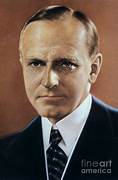Calvin Coolidge, the 30th President of the United States, concluded his term in office on March 4, 1929, handing over the reins to Herbert Hoover. By 1933, Coolidge had already left the political stage, but his influence lingered, and the nation grappled with the challenges of the Great Depression that began during Hoover's presidency. Coolidge, often referred to as "Silent Cal" for his reserved and taciturn demeanor, had served as president from 1923 to 1929. His tenure was marked by a commitment to limited government intervention in the economy and a focus on reducing taxes and government spending. Coolidge's philosophy aligned with a laissez-faire approach, believing that a less intrusive government would foster economic growth and prosperity. As the 1933 dawned, the nation was in the grip of the Great Depression, a devastating economic downturn that had cascading effects on every aspect of American life. While Coolidge's presidency had concluded before the full extent of the Depression unfolded, his policies and the laissez-faire mindset that characterized the 1920s faced criticism in the wake of the economic collapse. The stock market crash of 1929, just months after Coolidge left office, marked the beginning of the economic downturn. The ensuing years saw widespread unemployment, business closures, and a sharp decline in industrial production. As the nation grappled with the consequences of the economic collapse, calls for a more active government role in addressing the crisis grew louder. It was against this backdrop that Coolidge observed the unfolding events of 1933. In his retirement, he maintained a relatively low public profile, choosing not to actively engage in the political discourse of the time. Coolidge's silence on the pressing issues of the Great Depression contrasted with the increasingly vocal debate over the role of government in economic recovery. As President Franklin D. Roosevelt took office in March 1933, succeeding Hoover, the country witnessed a significant shift in governance. Roosevelt's New Deal, a series of bold and expansive programs aimed at addressing the economic challenges, represented a departure from Coolidge's philosophy of limited government intervention. The New Deal encompassed relief, recovery, and reform efforts, with initiatives such as the Civilian Conservation Corps (CCC), the Works Progress Administration (WPA), and the Social Security Act. Coolidge's legacy, once associated with prosperity and economic growth, faced reevaluation in the context of the Great Depression. Critics argued that the laissez-faire policies of the 1920s contributed to the severity of the economic crisis. While Coolidge had left office before the full impact of the Depression, his administration's approach to economic governance came under scrutiny. In the years following Coolidge's presidency, the nation underwent profound transformations in its economic and social fabric. The debate over the appropriate role of government persisted, shaping the trajectory of American politics for decades to come. Coolidge's time in office, once marked by a commitment to limited government, became a subject of historical analysis, and his legacy evolved in the face of the unprecedented challenges posed by the Great Depression and the subsequent shift in political philosophy that characterized the 1930s.
1933 Calvin Coolidge
